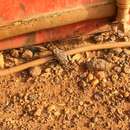ar
الأسماء في صفحات التنقل


The subdesert toad (Amietophrynus xeros) is a species of toad in the family Bufonidae. It is found in Algeria, Cameroon, Chad, Djibouti, Eritrea, Ethiopia, Gambia, Guinea, Kenya, Libya, Mali, Mauritania, Niger, Senegal, Somalia, Sudan, Tanzania, Uganda, Western Sahara, possibly Angola, possibly Benin, possibly Burkina Faso, possibly Central African Republic, possibly Democratic Republic of the Congo, possibly Guinea-Bissau, and possibly Nigeria. Its natural habitats are dry savanna, subtropical or tropical dry shrubland, subtropical or tropical dry lowland grassland, intermittent rivers, intermittent freshwater marshes, freshwater springs, hot deserts, and arable land. Its conservation status is assessed by the International Union for Conservation of Nature as being of "least concern".[1]
The subdesert toad is a medium-sized species with a broad head and blunt snout. The dorsal surface bears conical warts tipped with black spines. This toad varies in colour from cream or pale grey to dark brown and has three pairs of symmetrical dark-edged markings and various other dark blotches. The underparts are cream with variable amounts of mottling. Females have pale throats while those of males are darker, and males also have vocal sacs on the throat and some irregular red markings on the outer thighs.[2]
The subdesert toad lives in arid regions and may aestivate for long periods. In northwestern Africa it is active between September and March with breeding taking place in September and October, clutches of eggs being laid in temporary ponds and pools in river beds. it is mainly nocturnal and feeds on small invertebrates such as spiders, beetles and other insects.[1][2]
The subdesert toad (Amietophrynus xeros) is a species of toad in the family Bufonidae. It is found in Algeria, Cameroon, Chad, Djibouti, Eritrea, Ethiopia, Gambia, Guinea, Kenya, Libya, Mali, Mauritania, Niger, Senegal, Somalia, Sudan, Tanzania, Uganda, Western Sahara, possibly Angola, possibly Benin, possibly Burkina Faso, possibly Central African Republic, possibly Democratic Republic of the Congo, possibly Guinea-Bissau, and possibly Nigeria. Its natural habitats are dry savanna, subtropical or tropical dry shrubland, subtropical or tropical dry lowland grassland, intermittent rivers, intermittent freshwater marshes, freshwater springs, hot deserts, and arable land. Its conservation status is assessed by the International Union for Conservation of Nature as being of "least concern".
Sclerophrys xeros es una especie de anfibios anuros de la familia Bufonidae.
Habita en el sur de Argelia, Camerún, Chad, Eritrea, Etiopía, Gambia, Guinea, Kenia, sudoeste de Libia, Malí, Mauritania, Níger, Senegal, Somalia, Sudán, Tanzania, Uganda, Yibuti, Sáhara Occidental y, posiblemente en Angola, Benín, Burkina Faso, República Centroafricana, República Democrática del Congo, Sudán del Sur, Guinea Bissau y Nigeria.
Su hábitat natural incluye sabanas secas, zonas secas de arbustos tropicales o subtropicales, praderas, ríos y marismas intermitentes de agua dulce, nacientes, desiertos y tierra arable.
Está amenazada por la pérdida de su hábitat natural en ciertas zonas de su distribución.
Amietophrynus xeros Amietophrynus generoko animalia da. Anfibioen barruko Bufonidae familian sailkatuta dago, Anura ordenan.
Sclerophrys xeros est une espèce d'amphibiens de la famille des Bufonidae[1].
Cette espèce se rencontre de 200 à 1 800 m d'altitude[1] :
Sa présence est incertaine en Angola, au Bénin, au Burkina Faso, en République centrafricaine, en République démocratique du Congo, en Guinée-Bissau, au Nigeria et au Soudan du Sud.
Les mâles mesurent de 52 à 86 mm et les femelles de 55 à 87 mm[2].
Sclerophrys chudeaui (Chabanaud, 1919) pourrait être synonyme de cette espèce[3].
Sclerophrys xeros est une espèce d'amphibiens de la famille des Bufonidae.
Sclerophrys xeros é uma espécie de anfíbio da família Bufonidae, que pode ser encontrada na Argélia, nos Camarões, no Chade, no Djibuti, na Eritreia, na Etiópia, em Gâmbia, na Guiné, no Quênia, na Líbia, no Mali, na Mauritânia, no Niger, em Senegal, na Somália, no Sudão, na Tanzânia, em Uganda e no Saara Ocidental. Habita locais de até 1 800 metros de altitude, podendo ser visto em desertos, zonas úmidas, campos, pântanos e savanas. Costuma ficar próxima a corpos d'água, como poças, oásis e leitos de rios secos.[1]
Os machos medem entre 52 e 86 milímetros, enquanto as fêmeas medem 55 e 87 milímetros. A coloração de seu dorso varia entre o creme e o cinza ou castanho, apresentando seis pares de manchas simétricas, sendo a quarta a maior, e, mais raramente, pode acontecer desses pares se fundirem em uma só mancha. Seu ventre possuir cor de creme, que é mosqueado nos machos, e o pescoço das fêmeas apresentam uma pigmentação mais clara, sendo nos machos totalmente escura. Alguns indivíduos possuem partes das coxas vermelho-escarlate, característica que só pode ocorrer em machos.[2]
Possuem glândulas parotoides parcialmente desenvolvidas e com formato de rim, estando presentes acima do tímpano, que é bem visível. Os machos possuem um único saco vocal, que está presente na região subgular. Seu dorso possui inúmeros tubérculos, que podem ser assemelhar a um espinho ou ter um formato arredondado, costumando estar alinhadas com a coluna vertebral. Sua pele ventral é levemente granulada, mas sem apresentar asperidade. Os machos possuem glândulas alongadas proeminentes sob a pele, e durante o período reprodutivo, desenvolvem almofadas nupciais nos três primeiros dedos.[2]
Sua vocalização dura entre 0,36 e 0,4 segundos, com a frequência dominante em 880 hertz, e composta por uma série complexa de pulsos, que podem ser descritos de forma onomatopeica como "hoot", semelhante ao som emitido por uma coruja. Seu coaxar pode variar de indivíduo para indivíduo, principalmente quando de tamanhos diferentes.[2]
Sclerophrys xeros é uma espécie de anfíbio da família Bufonidae, que pode ser encontrada na Argélia, nos Camarões, no Chade, no Djibuti, na Eritreia, na Etiópia, em Gâmbia, na Guiné, no Quênia, na Líbia, no Mali, na Mauritânia, no Niger, em Senegal, na Somália, no Sudão, na Tanzânia, em Uganda e no Saara Ocidental. Habita locais de até 1 800 metros de altitude, podendo ser visto em desertos, zonas úmidas, campos, pântanos e savanas. Costuma ficar próxima a corpos d'água, como poças, oásis e leitos de rios secos.